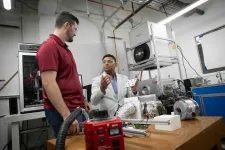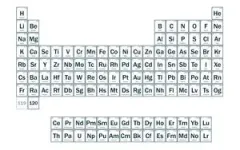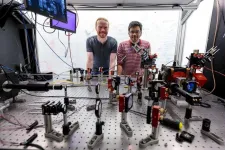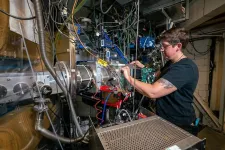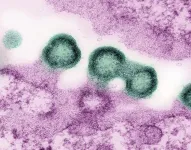(Press-News.org) Earth’s atmosphere holds an ocean of water, enough liquid to fill Utah’s Great Salt Lake 800 times.
Extracting some of that moisture is seen as a potential way to provide clean drinking water to billions of people globally who face chronic shortages.
Existing technologies for atmospheric water harvesting (AWH) are saddled with numerous downsides associated with size, cost and efficiency. But new research from University of Utah engineering researchers has yielded insights that could improve efficiencies and bring the world one step closer to tapping the air as a culinary water source in arid places.
The study unveils the first-of-its-kind compact rapid cycling fuel-fired AWH device. This two-step prototype relies on adsorbent materials that draw water molecules out of non-humid air, then applies heat to release those molecules into liquid form, according to Sameer Rao, senior author of the study published Monday and an assistant professor of mechanical engineering.
“Hygroscopic materials intrinsically have affinity to water. They soak up water wherever you go. One of the best examples is the stuff inside diapers,” said Rao, who happens to be the father of an infant son. “We work with a specific type of hygroscopic material called a metal organic framework.”
Rao likened metal organic frameworks to Lego blocks, which can be rearranged to build all sorts of structures. It this case they are arranged to create a molecule ideal for gas separation.
“They can make it specific to adsorb water vapor from the air and nothing else. They're really selective,” Rao said. Developed with graduate student Nathan Ortiz, the study’s lead author, this prototype uses aluminum fumarate that was fashioned into panels that collect the water as air is drawn through.
“The water molecules themselves get trapped on the surfaces of our material, and that's a reversible process. And so instead of becoming ingrained into the material itself, it sits on the walls,” Ortiz said. “What's special about these absorbent materials is they have just an immense amount of internal surface area. There's so many sites for water molecules to get stuck.”
Just a gram of this material holds as much surface area as two football fields, according to Rao. So just a little material can capture a lot of water.
“All of this surface area is at the molecular scale,” Rao said. “And that's awesome for us because we want to trap water vapor onto that surface area within the pores of this material.”
Funding for the research came from the DEVCOM Soldier Center, a program run by the Department of Defense to facilitate technology transfer that supports Army modernization. The Army’s interest in the project stems from the need to keep soldiers hydrated while operating in remote areas with few water sources.
“We specifically looked at this for defense applications so that soldiers have a small compact water generation unit and don’t need to lug around a large canteen filled with water,” Rao said. “This would literally produce water on demand.”
Rao and Ortiz have filed for a preliminary patent based on the technology, which addresses non-military needs as well.
“As we were designing the system, I think we also had perspective of the broader water problem. It's not just a defense issue, it's very much a civilian issue,” Rao said. “We think in terms water consumption of a household for drinking water per day. That's about 15 to 20 liters per day.”
In this proof of concept, the prototype achieved its target of producing 5 liters of water per day per kilogram of adsorbent material. In a matter of three days in the field, this devise would outperform packing water, according to Ortiz.
In the device’s second step, the water is precipitated into liquid by applying heat using a standard-issue Army camping stove. This works because of the exothermic nature of its water collecting process.
“As it collects water, it's releasing little bits of heat. And then to reverse that, we add heat,” Ortiz said. “We just put a flame right under here, anything to get this temperature up. And then as we increase the temperature, we rapidly release the water molecules. Once we have a really humid airstream, that makes condensation at ambient temperature much easier.”
Nascent technologies abound for atmospheric water harvesting, which is more easily accomplished when the air is humid, but none has resulted in equipment that can be put to practical use in arid environments. Ortiz believes his device can be the first, mainly because it is powered with energy-dense fuel like the white gasoline used in camping stoves.
The team decided against using photovoltaics.
“If you're reliant on solar panels, you're limited to daytime operation or you need batteries, which is just more weight. You keep stacking challenges. It just takes up so much space,” Ortiz said. “This technology is superior in arid conditions, while refrigeration is best in high humidity.”
######
The study, “Compact rapid cycling fuel-fired atmospheric water harvesting device for all-day water production,” appeared July 22 in the journal Cell Reports Physical Science. Funding came from the DEVCOM Soldier Center and the National Science Foundation.
END
Quantum information systems offer faster, more powerful computing methods than standard computers to help solve many of the world’s toughest problems. Yet fulfilling this ultimate promise will require bigger and more interconnected quantum computers than scientists have yet built. Scaling quantum systems up to larger sizes, and connecting multiple systems, has proved challenging.
Now, researchers at the University of Chicago’s Pritzker School of Molecular Engineering (PME) have discovered how to combine two powerful technologies—trapped atom arrays and photonic devices—to ...
Scientists at the Department of Energy’s Lawrence Berkeley National Laboratory (Berkeley Lab) are credited in the discovery of 16 of the 118 known elements. Now they’ve completed the crucial first step to potentially create yet another: element 120.
Today, an international team of researchers led by Berkeley Lab’s Heavy Element Group announced that they have made known superheavy element 116 using a titanium beam, a breakthrough that is a key stepping stone towards making element 120. The result was presented today at the Nuclear Structure 2024 conference; the science paper will be posted on the online repository ...
There’s a glaring gap in our knowledge of cell metabolism: in many cases, we still don’t know exactly how nutrients are transported into the cell. Without that understanding, it’s extremely difficult, if not impossible, to develop treatments for the many diseases linked to the protein transporters that drive metabolism. Now, a new study in Nature Genetics presents a tool to map these metabolic gene functions more precisely. The platform, dubbed GeneMAP, has already identified one key gene-metabolite association at the heart of mitochondrial metabolism.
GeneMAP was developed in the laboratory of Kivanç Birsoy, ...
iobhan Brady, a professor in the Department of Plant Biology and Genome Center at the University of California, Davis, has been selected as a Howard Hughes Medical Institute (HHMI) Investigator. The prestigious Investigator program, which Brady describes as “life changing,” will provide her with roughly $9 million in research support over a seven-year term, with the option to renew.
Brady’s research aims to understand how plants use their roots to respond to environmental stressors, and to use this information to develop plants that are better able to respond to climate ...
Long-acting injectable cabotegravir (CAB-LA) was safe and well tolerated as HIV pre-exposure prophylaxis (PrEP) before and during pregnancy in the follow-up phase of a global study among cisgender women. The analysis of outcomes from more than 300 pregnancies and infants will be presented at the 2024 International AIDS Conference (AIDS 2024) in Munich, Germany.
“Cisgender women experience biological changes and social dynamics that can increase their likelihood of acquiring HIV during pregnancy and the postnatal period, and we need to offer them evidence-based options when they may need them most,” said Jeanne Marrazzo, M.D., M.P.H., ...
CAMBRIDGE, MA – One thing that makes large language models (LLMs) so powerful is the diversity of tasks to which they can be applied. The same machine-learning model that can help a graduate student draft an email could also aid a clinician in diagnosing cancer.
However, the wide applicability of these models also makes them challenging to evaluate in a systematic way. It would be impossible to create a benchmark dataset to test a model on every type of question it can be asked.
In a new paper, MIT researchers took a different approach. They ...
Researchers working at the forefront of an emerging photovoltaic (PV) technology are thinking ahead about how to scale, deploy, and design future solar panels to be easily recyclable.
Solar panels made of perovskites may eventually play an important role amid global decarbonization efforts to reduce greenhouse gas emissions. As the technology emerges from the testing stages, it is a perfect time to think critically about how best to design the solar panels to minimize their impact on the environment decades from now.
“When you have a technology in its very early stages, you have the ability to design it better. It’s a cleaner slate,” said Joey Luther, a senior ...
Looking for a Medicare Advantage plan with a five-star quality rating? You’re less likely to find one available to you if you live in a county with higher poverty and unemployment, finds a new study published in JAMA Network Open.
These geographic disparities may be contributing to unequal health outcomes and limiting federal funds from reaching the regions most in need, according to the researchers.
“What this means is that Medicare beneficiaries living in counties with greater social disadvantage ...
The overarching goal of all carbon capture and storage projects is the same: Keep carbon dioxide (CO2) emissions out of the atmosphere by storing them in the subsurface for good.
One way to do that is to inject the CO2 into a reservoir space that’s covered with a big lid – an impermeable caprock that can keep the gas in place and stop any upward flow in its tracks. That’s the model that petroleum exploration has relied on for decades when searching for oil traps, and it works for both oil and CO2. But according to research led by The University of Texas at Austin’s Bureau of Economic Geology, subsurface ...
A new publication from Opto-Electronic Advances; DOI 10.29026/oea.2024.240036 , discusses sharp temperature reduction for quantum dots in polymer by highly efficient heat dissipation pathways.
Quantum dots (QDs), a kind of luminescent nanocrystals featuring size-tunable emission spectra and superior color purity are widely applied in optoelectronic fields. However, these particles are facing luminous efficiency degradation due to their temperature-sensitive characteristic and the high temperature in optoelectronic ...
